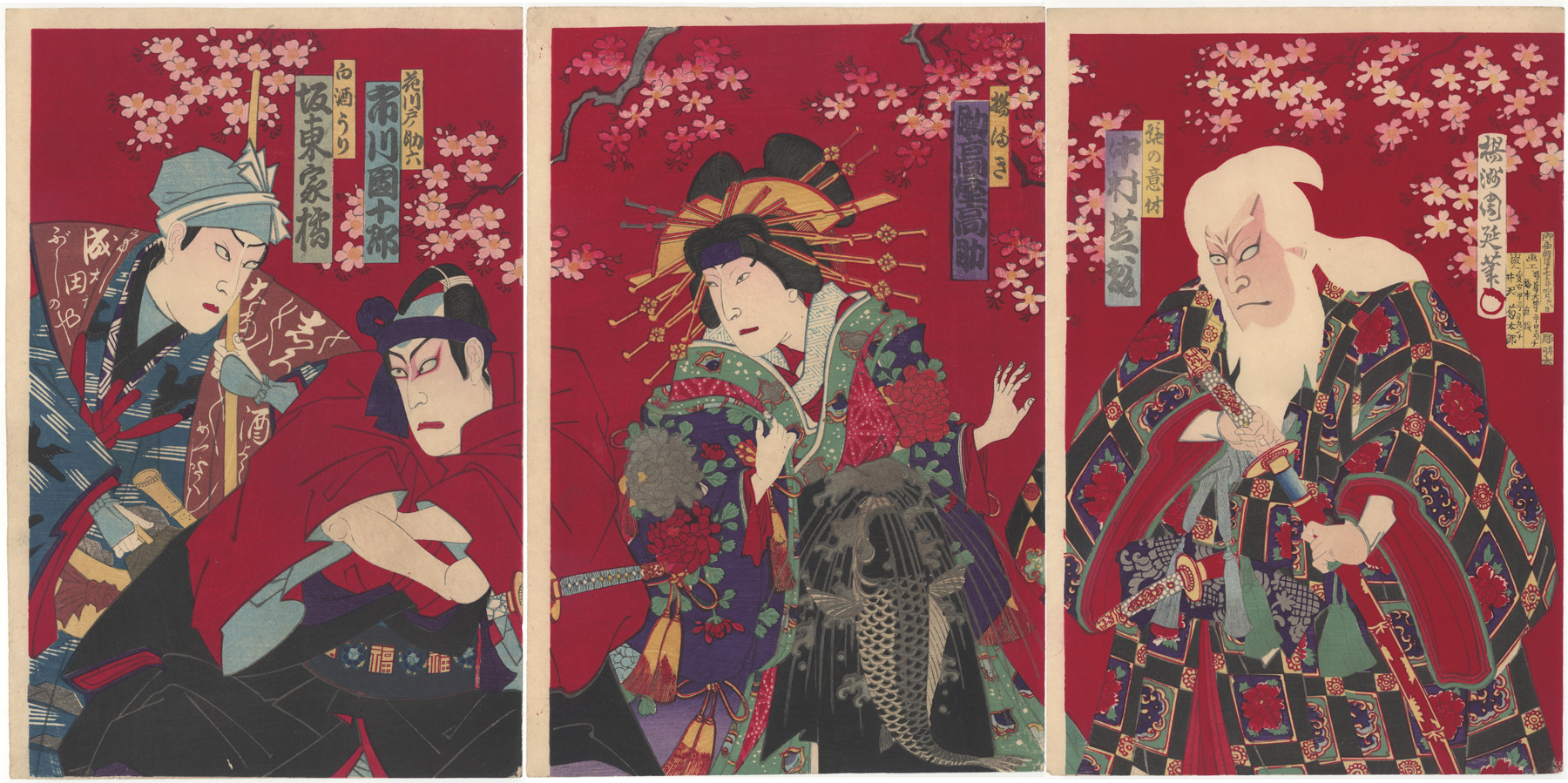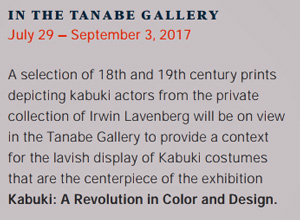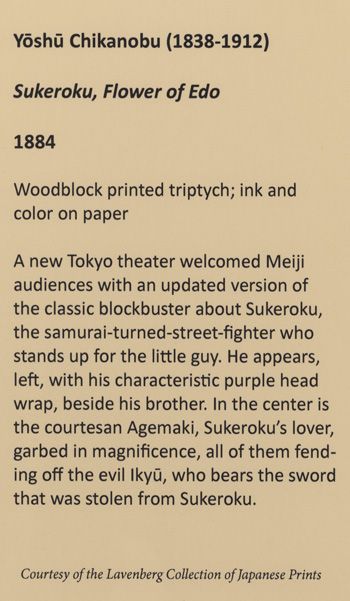About This Print
Admire these fantastic costumes adorning the actors in this scene from the kabuki play Sukeroku, Flower of Edo. They "are models of chic fashion, the robes for the courtesan Agemaki are the most lavish in kabuki and even the villain Ikkyu [Ikyū] has a handsome and heavily decorated kimono."1On the right we see the evil old Ikyū, as played by Nakamura Shikan IV, grasping the sword stolen from Sukeroku. In the center is the beautiful courtesan Agemaki, lover of Sukeroku, played by Sukedakaya Takasuke IV. On the left are Sukeroku, a dashing otokodate2 and seeker of his stolen sword, played by Ichikawa Danjūrō IX, and to his left Sukeroku's brother Shimbei, disguised as a white sake seller (shirozakeuri), played by Bandō Kakitsu. Cherry blossoms adorn the background, as this play takes place in cherry blossom season in the Yoshiwara pleasure district.

Caught in the Act: Woodblock Kabuki Prints from the Lavenberg Collection of Japanese Prints
July 29 - September 3, 2017 in the Tanabe Gallery at the Portland Japanese Garden

date to the Meiji Period (1868-1912), after Edo had become Tokyo, when Japan was modernizing rapidly. New technology introduced from the West meant the introduction of brilliant colors derived from synthetic dyes that smacked of evolving times. Even so, traditions in kabuki print design remained: details masterfully rendered; cartouches giving the actor's name and role; the action unfolding across multiple sheets of paper.
The Play - Sukeroku Yukari no Edo Zakura (Sukeroku, Flower of Edo 助六由縁江戸桜)
Source: Kabuki Eighteen Traditional Dramas, Kawatake Toshio, Chronicle Books, 1985, p. 6-7 and as footnoted.
Commonly known as Sukeroku, this was the first play to be included by Ichikawa Danjūrō VII in his 1840 collection of plays the Kabuki Eighteen (Kabuki Jūhachiban).3
Main Characters: Agemaki, the most beautiful and famous courtesan of Yoshwara, a red-light district in Edo; Sukeroku or Sogo Gorō, a chivalrous commoner and Agemaki's lover, who looks very handsome in his black kimono, kumadori mukimikuma makeup, and a purple headband4; and Ikyū, an enormously rich man who tries to win Agemaki's favor.
Sukeroku is frequenting licensed quarters and picks quarrels to find his sword Tomikirimaru which has been stolen from him. Sukeroku insults Ikyū particularly offering him a pipe holding it between his toes and even taking off his footwear and putting it on Ikyū's head, all to make him draw his sword. [He also refers to Ikyū as a "white-beared, lice-infested snake who stinks of aloes.]5 Ikyū stoically bears it but later, when he tries to trick Sukeroku into making treasonable anti-Shogunate statements he gets caught in his own trap when he draws his sword to slice an incense burner. Sukeroku immediately recognizes his sword but Ikyū hastily departs. Sukeroku waits for him to clam his sword and in the end kills both Ikyū and his retainer. When he is about to be caught by the authorities, Sukeroku hides in a barrel full of water and later Agemaki comes to help him escape.
As in the case of this April 29, 1894 performance, this play, set in Yoshiwara during the cherry blossom season, is traditionally staged in March or April.
The character of Sukeroku, a handsome otokodate, is likely taken from the real life seventeenth-century otokodate Fukamai Jikyū.6 The first Sukeroku play was written in 1713 by Tsuuchi Jihei II (1679-1760) for Ichikawa Danjuro II at a time when Fukami Jikyū was in exile on the island of Oki.
The Actors Pictured
From right to left, the actors and their roles as given in the cartouches on the print are:
Nakamura Shikan IV, (<4> 中村芝翫) as : Hige no Ikyū 髭の意休
Sukedakaya Takasuke IV (<4>助高屋高助) as Agemaki 揚まき
Ichikawa Danjūrō IX (<9>市川団十郎 ) as Hanakawado no Sukeroku 花川戸ノ助六
Bandō Kakitsu I (<1> 坂東家橘) as Shirozakeuri 白酒うり
latest revision:
Nakamura Shikan IV, (<4> 中村芝翫) as : Hige no Ikyū 髭の意休
Sukedakaya Takasuke IV (<4>助高屋高助) as Agemaki 揚まき
Ichikawa Danjūrō IX (<9>市川団十郎 ) as Hanakawado no Sukeroku 花川戸ノ助六
Bandō Kakitsu I (<1> 坂東家橘) as Shirozakeuri 白酒うり
For background on the actors pictured see their respective entries in the article The Kabuki Actor on this site.
1 NHK’s Kabuki Cool website http://www3.nhk.or.jp/nhkworld/en/tv/kabukikool/kabuki_program_2015_11.html
2 An otokodate ("chivalrous commoner") took it upon him to defend the interests of the poor and oppressed. They were celebrated figures in novels and they figure prominently as heroes in kabuki plays, often in opposition to villains. In these plays, they are often the sons of samurai who have renounced their status in order to defend the interests of the poor. In keeping with their showy characters they wear spectacular kimono, and are skilled and courageous fighters. [The Beauty & The Actor, Ukiyo-e: Japanese Prints from the Rijksmuseum Amsterdam and the Rijksmuseum voor Volkenkunde, Leiden, Matthi Forrer, C. v. Rappard-Boon, Hotei Publishing, Amsterdam / Leiden, 1995, p. 191]
2 An otokodate ("chivalrous commoner") took it upon him to defend the interests of the poor and oppressed. They were celebrated figures in novels and they figure prominently as heroes in kabuki plays, often in opposition to villains. In these plays, they are often the sons of samurai who have renounced their status in order to defend the interests of the poor. In keeping with their showy characters they wear spectacular kimono, and are skilled and courageous fighters. [The Beauty & The Actor, Ukiyo-e: Japanese Prints from the Rijksmuseum Amsterdam and the Rijksmuseum voor Volkenkunde, Leiden, Matthi Forrer, C. v. Rappard-Boon, Hotei Publishing, Amsterdam / Leiden, 1995, p. 191]
3 For more information on the Kabuki Eighteen see Title Page from the series The Kabuki Eighteen (Kabuki Jūhachiban).
4 The Kabuki Handbook states that as originally played by Ichikawa Danjūrō II, Sukeroku "epitomized all the aspirations of the humble, romantic townsfolk. He even went so far as to wear a head-band and socks dyed with a certain purple dye which, because of the enormous cost of importing it from China, only the Shogun himself had hitherto been accustomed to use." [The Kabuki Handbook, Aubrey S. & Giovanna M. Halford, Charles E. Tuttle Company, 12th printing 1981, p. 322.]
5 The Kabuki Handbook, Aubrey S. & Giovanna M. Halford, Charles E. Tuttle Company, 12th printing 1981, p. 325.
6 For more information on Fukamai Jikyū see this collection's print The full moon coming with a challenge to flaunt its beautiful brow - Fukami Jikyū from the series One Hundred Aspects of the Moon.
Print Details
| IHL Catalog | #1275 |
| Title (Description) | Nakamura Shikan IV, Sukedakaya Takasuki IV, Ichikawa Danjūrō IX and Bandō Kakitsu (in the play Sukeroku, Flower of Edo at the Shintomiza) |
| Artist | Yōshū Chikanobu (1838-1912) |
| Signature |  楊洲周延筆 |
| Seal | red Toshidama seal [年玉印] beneath signature, as shown above |
| Publication Date |  |
| Publisher |  Left Column (publisher's information) 出板人 井沢菊太郎 Shuppanjin Izawa Kikutarō 愛宕甼三丁目五バンチ Atagomachi Sanchōme 5-banchi Right Column (artist's information) 画工 橋本直義 Gakō Hashimoto Naoyoshi 湯嶌天神丁三丁目十一バンチ Yushima Tenjinchō Sanchōme 11-banchi [Marks: pub. ref. 174; seal similar to 26-042] |
| Carver |  彫弥太 Hori Yata; seal of the carver 渡辺 弥太郎 Watanabe Yotarō |
| Impression | excellent |
| Colors | excellent |
| Condition | excellent – full-size separate sheets; not backed; minor wrinkling |
| Genre | ukiyo-e; yakusha-e |
| Miscellaneous | |
| Format | vertical oban triptych |
| H x W Paper | 14 11/16 x 9 13/16 in. (37.3 x 24.9 cm) each sheet |
| H x W Image | 14 3/16 x 9 3/8 in. (36 x 23.8 cm) each sheet |
| Literature | |
| Collections This Print | Tokyo Metropolitan Library M348-48-1(3) |
8/6/2021




